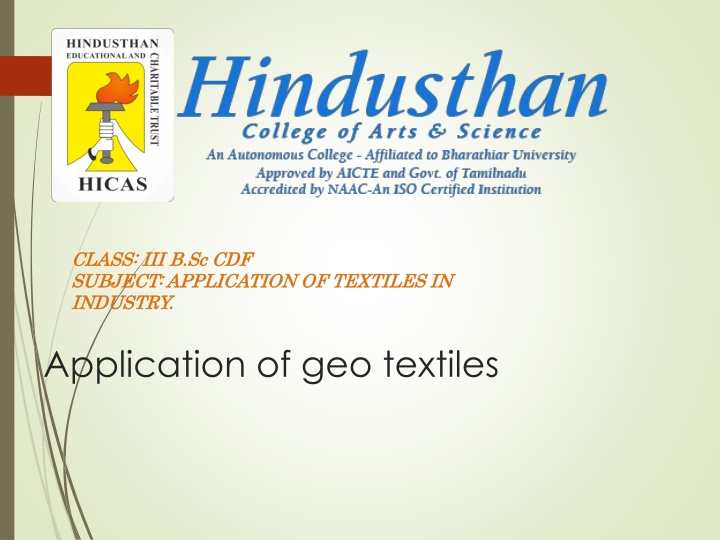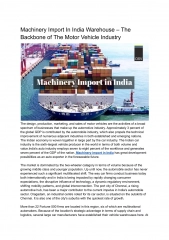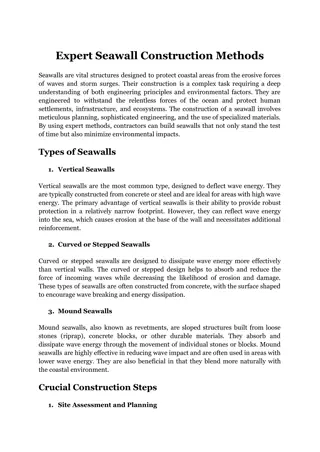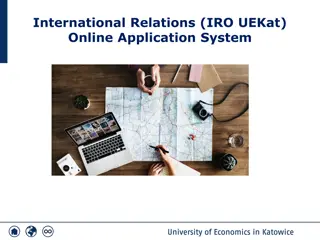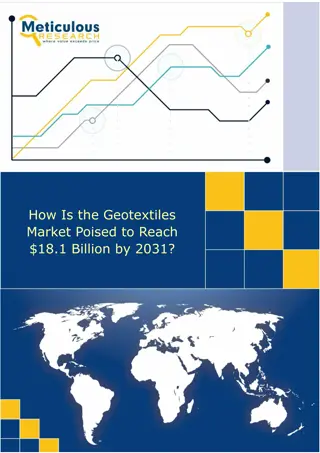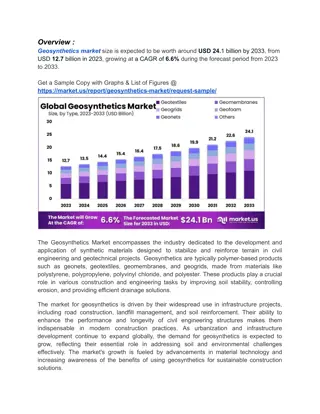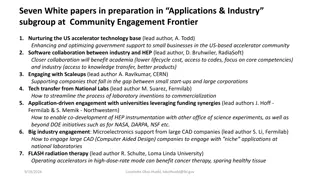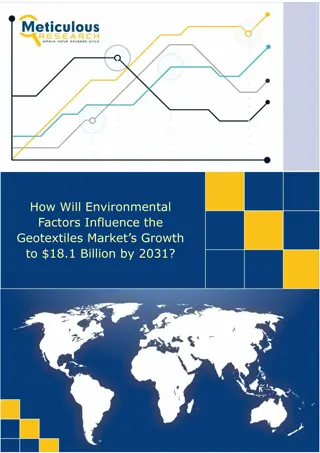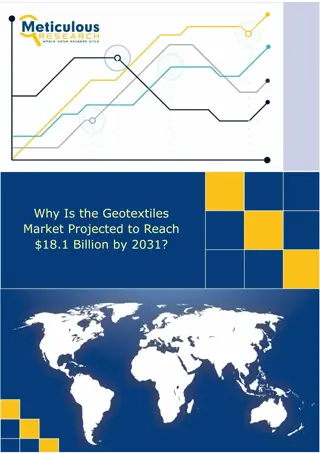Application of Geotextiles in Industry
Geotextiles are permeable fabrics used with soil for separating, filtering, reinforcing, protecting, or draining. They come in forms like woven, needle-punched, or heat-bonded. Geotextile composites, such as geogrids, offer durability and versatility in applications like roads, landfills, retaining walls, and more in civil engineering projects.
Download Presentation

Please find below an Image/Link to download the presentation.
The content on the website is provided AS IS for your information and personal use only. It may not be sold, licensed, or shared on other websites without obtaining consent from the author.If you encounter any issues during the download, it is possible that the publisher has removed the file from their server.
You are allowed to download the files provided on this website for personal or commercial use, subject to the condition that they are used lawfully. All files are the property of their respective owners.
The content on the website is provided AS IS for your information and personal use only. It may not be sold, licensed, or shared on other websites without obtaining consent from the author.
E N D
Presentation Transcript
CLASS: III CLASS: III B.Sc SUBJECT: APPLICATION OF TEXTILES IN SUBJECT: APPLICATION OF TEXTILES IN INDUSTRY. INDUSTRY. B.Sc CDF CDF Application of geo textiles
Online class(Google meet)prepared by: M.Rishana class: III B.Sc CDF Date:25/10/2021 GEO TEXTILES
Online class(Google meet)prepared by: M.Rishana class: III B.Sc CDF Date:25/10/2021 INTRODUCTION Geotextiles are permeable fabrics which, when used in association with soil, have the ability to separate, filter, reinforce, protect, or drain. Typically made from polypropylene or polyester, geotextile fabrics come in three basic forms: woven (resembling mail bag sacking), needle punched (resembling felt), or heat bonded (resembling ironed felt).
Online class(Google meet)prepared by: M.Rishana class: III B.Sc CDF Date:25/10/2021 Geotextile composites have been introduced and products such as geogrids and meshes have been developed. Geotextiles are able to withstand many things, are durable, and are able to soften a fall if someone falls down. Overall, these materials are referred to as geosynthetics and each configuration -geonets, geosynthetic clay liners, geogrids, geotextile tubes, and others -can yield benefits in geotechnical and environmental engineering design.
Online class(Google meet)prepared by: M.Rishana class: III B.Sc CDF Date:25/10/2021 GEOTEXTILE APPLICATIONS Geotextiles can be used in many common applications: Unpaved and paved roads in airport runways Landfills and stone base courses Sidewalks and sand drainage layers Parking lots and curb areas Green areas and recreational facilities Retaining wall structures Duct banks and pipe trenches
Online class(Google meet)prepared by: M.Rishana class: III B.Sc CDF Date:25/10/2021 Geotextiles and related products have many applications and currently support many civil engineering applications including roads, airfields, railroads, embankments, retaining structures, reservoirs, canals, dams, bank protection, coastal engineering and construction site silt fences or geotube. Usually geotextiles are placed at the tension surface to strengthen the soil.
Online class(Google meet)prepared by: M.Rishana class: III B.Sc CDF Date:25/10/2021 Geotextiles are also used for sand dune armoring to protect upland coastal property from storm surge, wave action and flooding. A large sand-filled container (SFC) within the dune system prevents storm erosion from proceeding beyond the SFC. Using a sloped unit rather than a single tube eliminates damaging scour
Online class(Google meet)prepared by: M.Rishana class: III B.Sc CDF Date:25/10/2021 Erosion control manuals comment on the effectiveness of sloped, stepped shapes in mitigating shoreline erosion damage from storms. Geotextile sand-filled units provide a "soft" armoring solution for upland property protection. Geotextiles are used as matting to stabilize flow in stream channels and swales
Online class(Google meet)prepared by: M.Rishana class: III B.Sc CDF Date:25/10/2021 Geotextiles can improve soil strength at a lower cost than conventional soil nailing. In addition, geotextiles allow planting on steep slopes, further securing the slope. Geotextiles have been used to protect the fossil hominid footprints of Laetoli in Tanzania from erosion, rain, and tree roots. In building demolition, geotextile fabrics in combination with steel wire fencing can contain explosive debris.
Online class(Google meet)prepared by: M.Rishana class: III B.Sc CDF Date:25/10/2021 Functions 1. Separation Geotextiles will prevent two soil layers of different particle sizes from mixing with each other, as is illustrated the image below. . 2. Drainage Geotextiles will efficiently collect superfluous water from structures, such as rainwater or surplus water, from the soil and discharge it.
Online class(Google meet)prepared by: M.Rishana class: III B.Sc CDF Date:25/10/2021 . 3. Filtration Geotextiles are an ideal interface for reverse filtration in the soil adjacent to the geotextile. In all soils water allows fine particles to be moved. Part of these particles will be halted at the filter interface; some will be halted within the filter itself while the rest will pass into the drain. The complex needle-punched structure of the geotextile enables the retention of fine particles without reducing the permeability of the drain.
Online class(Google meet)prepared by: M.Rishana class: III B.Sc CDF Date:25/10/2021 4. Reinforcement Heavy geotextiles can be used to reinforce earth structures by means of fill materials. Thanks to their high soil fabric friction coefficient and high tensile strength, they are an ideal reinforcement solution. 5. Protection Geotextiles are an ideal protection from erosion of earth embankments by wave action, currents or repeated drawdown. A layer of geotextiles can be placed so as to prevent leaching of fine material. They can be used for rock beaching or as mattress structures. They can even easily be placed under water
Online class(Google meet)prepared by: M.Rishana class: III B.Sc CDF Date:25/10/2021 drinage
Online class(Google meet)prepared by: M.Rishana class: III B.Sc CDF Date:25/10/2021
Online class(Google meet)prepared by: M.Rishana class: III B.Sc CDF Date:25/10/2021
Online class(Google meet)prepared by: M.Rishana class: III B.Sc CDF Date:25/10/2021
Online class(Google meet)prepared by: M.Rishana class: III B.Sc CDF Date:25/10/2021
Online class(Google meet)prepared by: M.Rishana class: III B.Sc CDF Date:25/10/2021
Online class(Google meet)prepared by: M.Rishana class: III B.Sc CDF Date:25/10/2021
Online class(Google meet)prepared by: M.Rishana class: III B.Sc CDF Date:25/10/2021 Mobiltech textiles are an integral aspect of technical textiles. Since it may not be classified in conventional textile, it is more than a textile technological, and mechanical application in the automobile industry. Automobile Textiles (Mobiltech) makes revolution widely in the modern transportation ecosystem. Mobiltech textiles refer to a specified area of technical textiles used in the automotive or transportation sector. Mobiltech means the Textiles Technology Integrated with Automobile, are known as Mobiltech textiles. Mobiltech is also known as Mobiltex. It includes a wide range of applications in automotive and its components (including aerospace, aircraft, railways, and marine vehicles). It covers not only the isolation and protection aspect! But also concentrate on style and comfort.
Online class(Google meet)prepared by: M.Rishana class: III B.Sc CDF Date:25/10/2021 How Mobiltech textiles come into Technical Textile? Mobiltech technical textiles have changed and enhanced car seats, seat covers, dashboards, and other materials for both consumers and automakers. From their brand call, it s also got popular instead of Automobile Textiles. Mobiltech has continued to innovate in the automobile industry, leading them to create fabrics that can be used on dashboards. They can do this because of their patented materials, making it possible for Mobiltech to withstand extreme temperatures like hot or cold weather without breaking down.
Online class(Google meet)prepared by: M.Rishana class: III B.Sc CDF Date:25/10/2021 Classification of Mobiltech: According to the Application, Mobiltech is classified into three categories. These areas: 1.Visible Component (Seat Upholstery, Carpet and Seat Belts, Headliners) 2.Concealed Components (Tire Chords Liners, NVH Components) 3.Others Components (airbags, car covers, belts, helmets, airline disposables, webbings for aircraft, seating fabrics, etc.)
Online class(Google meet)prepared by: M.Rishana class: III B.Sc CDF Date:25/10/2021 Fiber and Fabric use in Mobiltech s Applications Area Airbag and headliners Nylon, and natural fibers Polyester, nylon, or natural fibers blend with them Body cloth Seat belt Polyester, Natural fibers Package trays PP and nylon Interior carpet Nylon Door trim PP, nylon, polyester Trunk liners Polyester blends PET, PVC coated, or polymer-based nylon Trunk cover Composites of aramid fibers, or carbon fiber Clutch facings PET, glass, aramid fibers, nylon, rayon fibers Tyre and tire cord fabric
Online class(Google meet)prepared by: M.Rishana class: III B.Sc CDF Date:25/10/2021 Mobiltech Technical Textiles Application in Automobile Industry
Online class(Google meet)prepared by: M.Rishana class: III B.Sc CDF Date:25/10/2021 Mobiltech Application in Automotive Car Industry Application Area of Uses Textiles Integrated Technology Back Fabrics, Bolster Fabrics, Construction reinforcements, Trim or Toe Kick, Decorative Fabrics Hydro-entangled Needle Punch, Spunbonded, Natural fibers, and other synthetic fibers Seat Lower facings, Panel trim (door insert or bolster) Door Needle punch, Spunbonded Insulation Acoustic, Thermal resistance Needle punch, Spunbonded Facing, Backings (including mold release applications) Substrates Headliners Needle punch, Spunbonded Facing, Backings (including mold release applications) Substrates Hood liners Spun bond, Resign, Needle punch Rear Shelf Facings or Backings Needle punch Trunk liner, Reinforcement, load floors, decliners, seatback fabric fold-down seat, under the package Trunk Spun bond, Needle punch Carpet, Primary Backings, Secondary Backing Carpet Spun bond, Needle punch,
Online class(Google meet)prepared by: M.Rishana class: III B.Sc CDF Date:25/10/2021 Application Area of Mobiltech in the Automobile Industry 1. Seats The seat is the essential item in the automotive sector after the engine. It is the first and foremost thing when the customer sees when the vehicle door will be opened. Technical Textiles have become a more widely used material in seat coverings. Today polyester material and natural fibers blend to use to manufacture seats. 2. Head Liners Once headliner was covered only by the metal roof. Inside the vehicle formed of fabric, PVC. Today modern headliner laminates and joints together with multiple components. Each layer of technical textiles has an aesthetics specific purpose: reducing vibration clamping, sound insulation, and rigidity to the structure.
Online class(Google meet)prepared by: M.Rishana class: III B.Sc CDF Date:25/10/2021 3. Textiles For Noise Control Textiles have been used for noise control mechanisms since vehicle invention. The primary three mechanical properties and functional propertiesused to reduce; the first absorption, clamping, and noise isolation. 4. Cabin Air Filter In Automobile Industry, there are lots of filter materials used in an automobile. But most of them are manufactured from textile materials. Non-woven paper is used in the carburetor air filters, the oil filter. Modern nonwoven filterfabric application helps to get odour-free, as well as resistant to micro-organisms and high temperature. It s circulated in a regular supply with minimum airflow resistance to the maximum surface area.
Online class(Google meet)prepared by: M.Rishana class: III B.Sc CDF Date:25/10/2021 5. Carpets Carpet Carpets Carpet is a crucial part of every automotive interior. It has to withstand temperature extremes. Tufted cut-pile carpets, Needle-felt carpets are used with rubberized backing. 6. Interior Design Natural fiber-made automobile interiors are woven fabric, nonwoven melt-blown fabric, linen wool, felt, and even embroideries. Every seat pad, having a matching carpet to provide better interior looks. About 75% of Mobiltech is hugely used for seat belts and tire cords. It s also applicable for airbags, helmets, body covers, insulation felts, as well as in interior materials. Even Pre-Assembled Interior Components such as Door kick panels, roof linings, and insulation mechanism used coated laminated needle-punched nonwoven and warp knit.
Online class(Google meet)prepared by: M.Rishana class: III B.Sc CDF Date:25/10/2021 7. Engine Compartment and Filters Items Hoses, belts are reinforced with textile materials in automotive engines. Most Automobile filters manufacture from textiles, such as air filters and oil filters. The most essential part of these automobile filters is to filter the fluid before enters the engine. It separates dirt and dust particle enters into the automobile engine. The automobile industry is constantly evolving, with the latest models being more efficient, faster, and safer than ever before. The textile industry has also been revolutionized by new technologies that offer various textiles for automobiles. Innovative mobiltech materials have now been used in seats, headrests, sun visors, and floor mats to provide comfort and protective equipment while promoting safety for drivers. The mobiltech textiles industry focuses on innovative materials that can withstand extreme temperatures, moisture, and wear while providing a luxurious feeling to the driver. It is made of natural fibers such as cotton or wool, which resist shrinkage and fading with constant use. Automotive textile manufacturing industries also offer synthetic fabrics for those who want minimal upkeep but prefer the look of natural fibers.
Online class(Google meet)prepared by: M.Rishana class: III B.Sc CDF Date:25/10/2021 The use of automotive textiles in the industry is not new, but the quality and variety have grown immensely with time as technology keeps advancing. Automobile manufacturers now offer a selection from which to choose that can suit any driver s needs, whether they want durable fabrics for extended trips or fine, soft materials for short errands around town. Mobiltech textiles are improving the safety of drivers. The latest models come with advanced features such as built-in airbags, anti-lock brakes, and seat belts to keep passengers secure in a crash or sudden stop. Automobile textile manufacturers have developed their technologies for flame retardant fabrics, provide protection from UV rays, and offer sound insulation.
